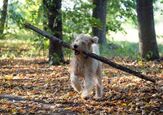New Research Reveals Dog Diversity Dates Back to the Ice Age

From the adorable little Pug snuggling on the couch to the towering Irish Wolfhound patrolling the yard, there is no questioning the incredible physical diversity of today’s domestic dog.
It has been a commonly held belief among the dog-loving community that this variety was a recent development, resulting from the creation of modern dog breeds. Throughout the years, breeders and dog enthusiasts have focused on intensive, aesthetic-focused selective breeding to meet the breed requirements established by the formation of kennel clubs and the development of structured dog breeds as we know them today.
So, are these differences the result of a few hundred years of human intervention aimed at creating dogs with specific looks and features?
New research suggests there may be more to it than we realize! The research, published in the journal Science, suggests that the fundamental differences seen in dogs, specifically in their skulls, date back to the tail end of the last Ice Age, at least 11,000 years ago.
Scientists examined a massive collection of 643 skulls, including those of modern dogs, ancient dogs, modern wolves, and ancient wolves, covering roughly 50,000 years of canine history. They found that the emergence of recognizable domestic dog features and significant variation between dogs appeared soon after they branched out from their wolf ancestors.
“During domestication, dog skulls became proportionally shorter and wider compared with those of wolves,” explained bioarchaeologist and study co-lead author Carly Ameen of the University of Exeter in England.
The dog was the very first animal domesticated by people. While ancient dogs didn’t possess the extreme facial features of a modern Bulldog, Ameen notes that dogs from the Mesolithic and Neolithic periods already showed about half the skull variation we see in all the different breeds today. But back then, they weren’t picking dogs based on how cute they looked; they were choosing them strictly for what they could do, their function and purpose.
The relationship between humans and dogs was purely a working partnership for millennia. Dogs fulfilled crucial roles, including serving as hunting partners, herders, guards, and sled pullers. Early human societies selected dogs based on what they could best do, and with those practical needs came related physical features. For example, a shorter, stronger snout performed better for gripping, while a longer muzzle was better for tracking.
It was only in recent centuries that the way dogs are viewed in society shifted. As dogs became more integrated into our lives beyond their functional roles, preferences driven by status and appearance began to take over. As breed standards were formalized, these differences intensified and grew into the dog breeds we recognize today.
What does all this mean for us as modern-day dog parents? The research is a powerful reminder that the dog sleeping at our feet (or in our bed) is the result of a vast history based on function and practicality. Their unique and adorable appearance is not just a product of 200 years of focused breeding; it’s a testament to an 11,000-year-old story of evolution, where their physical form adapted to help humans survive and thrive.
They were man's best friend back then and continue to be today.
Join the PetGuide community. Get the latest pet news and product recommendations by subscribing to our newsletter here.

Britt Kascjak is a proud pet mom, sharing her heart (and her home) with her “pack” which includes her husband John, their 2 dogs – Lucifer and Willow – and their 3 cats – Pippen, Jinx, and Theia. She has been active in the animal rescue community for over 15 years, volunteering, fostering and advocating for organizations across Canada and the US. In her free time, she enjoys traveling around the country camping, hiking, and canoeing with her pets.
More by Britt























